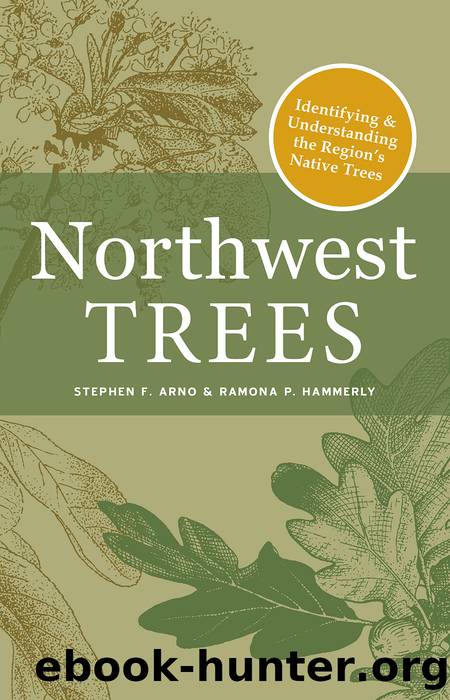Northwest Trees by Stephen F. Arno

Author:Stephen F. Arno
Language: eng
Format: epub
ISBN: 9781680515336
Publisher: Mountaineers Books
Published: 2020-11-15T00:00:00+00:00
HUMAN HISTORY
Hilary Stewartâs 1984 book, Cedar, explains how this tree provided a bountiful life for tribes of the Northwest coast. When a baby was born, it was placed on a cradle of firmly woven cedar roots, with a mattress and diapers of soft, shredded cedar bark. The mother wore a cedar-bark hat, cape, and skirt to protect her from rain and cold. The people used baskets woven from long, slender cedar twigs and roots. They boiled fish, clams, and other foods by placing fire-heated rocks in water-tight boxes fashioned from steamed, bent cedar âplanks.â Large cedar-wood boxes or root baskets were used to store foods for winter. Western redcedar also served many medicinal needs and has the most extensive catalog of uses by Native peoples among all North American plants (Moerman 1998).
Planks of various sizes and thicknesses were split by expert insertion of wedges into trunks of living or dead redcedar trees. Planks, poles, posts, and logs of cedar were used to construct their houses. In 1808 explorer Simon Fraser described a cedar-plank longhouse near present-day Vancouver, British Columbia, as being 650 feet (200 m) long by 60 feet (18 m) broad, under one roof, and containing apartments for families (Stewart 1984). Outside the house would stand a tall carved cedar memorial pole (totem pole) chronicling the family lineage and spiritual symbols.
Native peoples fashioned dugout canoes of many sizes from the trunk of a western red-cedar. Cedar canoes would carry the people along rivers and out into the salt water to fish for salmon or even whales. Cedar was also used to make the nets and harpoons. A gigantic ocean-going cedar canoe housed at the American Museum of Natural History in New York is 63 feet (19.3 m) long and 8 feet (2.4 m) wide, with a bow over 7 feet (2.2 m) high for throwing off high waves (Stewart 1984).
Pioneer settlers soon recognized many values of western redcedar as well. A few made temporary dwellings out of gigantic stumps. In 1898 Thomas Stringham, a settler in the Elwha River valley west of Port Angeles, Washington, made a family home and US post office (McDonald, Washington) out of a redcedar stump on his property. The tree, which had been hollowed out by decay and fires, had been logged to a very tall stump. Stringham cut a doorway on one side and built a roof of cedar shakes.
Another traditional and modern use of redcedar is for kindling. In the rain-soaked Northwest, firestarter is often a critical need, which cedar fills easily and abundantly. Many a wet, cold camper has been thankful to find a fallen redcedar and the surefire kindling that its trunk offers. The ease of splitting redcedar wood along flat planes continues to make hand-split cedar shakes prized for a durable, natural roof. A major caveat attends such an application, however. The roof is in effect made of kindling that can burn rapidly if a firebrand (from a woodstove or nearby forest fire) lands on it! Demand for western
Download
This site does not store any files on its server. We only index and link to content provided by other sites. Please contact the content providers to delete copyright contents if any and email us, we'll remove relevant links or contents immediately.
The Lonely City by Olivia Laing(4731)
Animal Frequency by Melissa Alvarez(4382)
All Creatures Great and Small by James Herriot(4215)
Walking by Henry David Thoreau(3880)
Exit West by Mohsin Hamid(3765)
Origin Story: A Big History of Everything by David Christian(3633)
COSMOS by Carl Sagan(3539)
How to Read Water: Clues and Patterns from Puddles to the Sea (Natural Navigation) by Tristan Gooley(3388)
Hedgerow by John Wright(3261)
The Inner Life of Animals by Peter Wohlleben(3246)
How to Read Nature by Tristan Gooley(3232)
How to Do Nothing by Jenny Odell(3220)
Project Animal Farm: An Accidental Journey into the Secret World of Farming and the Truth About Our Food by Sonia Faruqi(3163)
Origin Story by David Christian(3133)
Water by Ian Miller(3112)
A Forest Journey by John Perlin(3018)
The Plant Messiah by Carlos Magdalena(2868)
A Wilder Time by William E. Glassley(2805)
Forests: A Very Short Introduction by Jaboury Ghazoul(2778)
